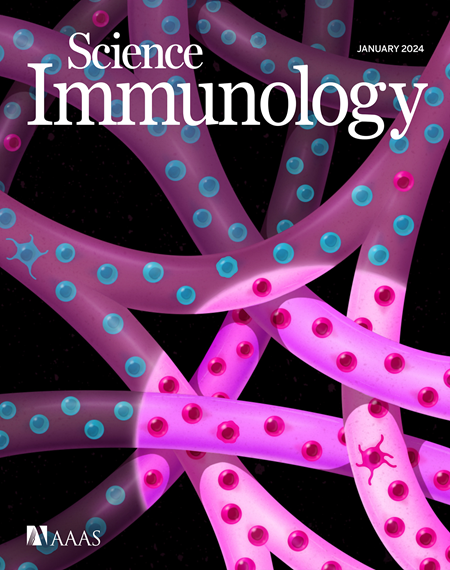DDX55通过抑制激活促进转座因子来保护naïve T细胞稳态
IF 16.3
1区 医学
Q1 IMMUNOLOGY
引用次数: 0
摘要
Naïve T细胞维持在稳态状态,以保持具有不同T细胞受体(TCR)库的稳定T细胞库,确保为启动做好准备。然而,控制naïve T细胞稳态和启动的潜在机制仍不清楚。利用基于机器学习的功能遗传筛选,我们确定DEAD-box解旋酶55 (Ddx55)是负责naïve T细胞稳态的首要因素。DDX55在naïve T细胞中高度表达,并抑制T细胞激活相关基因附近的增强子和启动子样转座元件(TEs)。Ddx55缺失导致这些te的抑制,导致te衍生的R环和基因组不稳定,最终破坏naïve T细胞稳态并消除T细胞增殖。在机制上,ddx55靶向的te含有髓细胞瘤癌基因(MYC)结合基序。DDX55直接结合MYC并限制其进入这些TE位点,从而阻止naïve T细胞中TE的不适当激活。因此,naïve T细胞利用DDX55作为T细胞活化的重要调节因子,确保其基因组稳定性和稳态维持。本文章由计算机程序翻译,如有差异,请以英文原文为准。
DDX55 safeguards naïve T cell homeostasis by suppressing activation-promoting transposable elements
Naïve T cells are maintained in a homeostatic state to preserve a stable T cell pool with diverse T cell receptor (TCR) repertoires, ensuring preparedness for priming. However, the underlying mechanisms controlling naïve T cell homeostasis and priming remain unclear. Leveraging a machine learning–based functional genetic screen, we identified DEAD-box helicase 55 (Ddx55) as the top factor responsible for naïve T cell homeostasis. DDX55 was highly expressed in naïve T cells and suppressed enhancer- and promoter-like transposable elements (TEs) near T cell activation–associated genes. Ddx55 loss led to derepression of these TEs, resulting in TE-derived R loops and genomic instability, ultimately disrupting naïve T cell homeostasis and abolishing T cell proliferation. Mechanistically, DDX55-targeted TEs harbored myelocytomatosis oncogene (MYC)–binding motifs. DDX55 directly bound MYC and restricted its access to these TE loci, thereby preventing inappropriate TE activation in naïve T cells. Thus, naïve T cells exploit DDX55 as a vital regulator of T cell activation, ensuring their genomic stability and homeostatic maintenance.
求助全文
通过发布文献求助,成功后即可免费获取论文全文。
去求助
来源期刊

Science Immunology
Immunology and Microbiology-Immunology
CiteScore
32.90
自引率
2.00%
发文量
183
期刊介绍:
Science Immunology is a peer-reviewed journal that publishes original research articles in the field of immunology. The journal encourages the submission of research findings from all areas of immunology, including studies on innate and adaptive immunity, immune cell development and differentiation, immunogenomics, systems immunology, structural immunology, antigen presentation, immunometabolism, and mucosal immunology. Additionally, the journal covers research on immune contributions to health and disease, such as host defense, inflammation, cancer immunology, autoimmunity, allergy, transplantation, and immunodeficiency. Science Immunology maintains the same high-quality standard as other journals in the Science family and aims to facilitate understanding of the immune system by showcasing innovative advances in immunology research from all organisms and model systems, including humans.
 求助内容:
求助内容: 应助结果提醒方式:
应助结果提醒方式:


